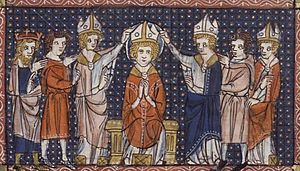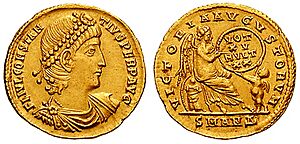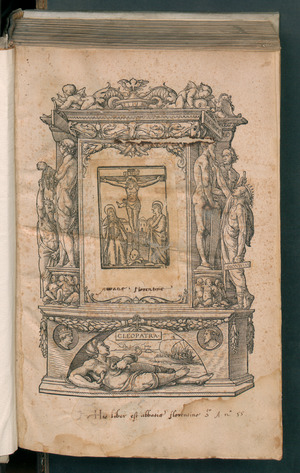Hilary of Poitiers facts for kids
Quick facts for kids SaintHilary of Poitiers |
|
|---|---|

The Ordination of Saint Hilary, from a 14th-century manuscript
|
|
| "Malleus Arianorum" and the "Athanasius of the West"; Bishop, Confessor and Doctor of the Church | |
| Born | c. 310 Pictavium, Gaul (modern-day Poitiers, France) |
| Died | c. 367 (aged c. 56–57) Poitiers |
| Venerated in | Roman Catholic Church Eastern Orthodox Church Anglican Communion Lutheran Church Oriental Orthodoxy |
| Canonized | Pre-Congregation |
| Feast | 13 January 14 January (Byzantine Christianity; some local calendars and pre-1970 General Roman Calendar) |
| Attributes | episcopal vestments, a mitre and crozier, and usually white and often long beard |
| Influences | Origen, Athanasius |
Hilary of Poitiers (Latin: Hilarius Pictaviensis; around 310–367 AD) was an important Bishop of Poitiers in ancient Gaul. He is also known as a Doctor of the Church, a special title given to saints who have taught important Christian ideas. People sometimes called him the "Hammer of the Arians" because he strongly disagreed with their beliefs. His name, Hilary, comes from a Latin word meaning "happy" or "cheerful." Besides his work as a bishop, Hilary was married and had a daughter named Abra of Poitiers, who became known for her kindness.
Contents
Hilary's Early Life and Faith
Hilary was born in Poitiers, a city in what is now France, around the early 300s AD. His parents were not Christians but were well-known in their community. Hilary received an excellent education, including learning Ancient Greek.
Later, he studied the Bible (Old and New Testaments). This led him to change his beliefs from Neo-Platonism to Christianity. He, his wife, and his daughter were all baptized and joined the Catholic Church.
Becoming a Bishop and Facing Challenges
The Christians in Poitiers respected Hilary greatly. Around 350 AD, they chose him to be their bishop. At this time, a belief called Arianism was spreading. Arians had different ideas about Jesus Christ and God. Hilary worked hard to stop these ideas from taking over the Western Church.
One of his first actions was to have some Arian bishops removed from the Church. He also wrote to Emperor Constantius II, asking him to stop the persecution of Christians who disagreed with Arianism. However, his efforts did not work at first. In 356 AD, the emperor sent Hilary away to Phrygia, a region far away.
Hilary was in exile for almost four years. It's thought he was sent away because he refused to agree with the condemnation of another important Christian leader, Athanasius of Alexandria. Some historians also suggest it might have been because of his political opposition to the emperor.
Working While in Exile
Even though he was far from home in Phrygia, Hilary continued to guide his church in Poitiers. He also wrote two very important books about Christian beliefs. One was called De synodis, written in 358 AD. In this book, he tried to explain the views of Eastern bishops on the Arian debate. He suggested that sometimes the differences were more about words than actual ideas.
His other major work was De Trinitate, written between 359 and 360 AD. This was the first time the complex ideas about the Trinity (God as Father, Son, and Holy Spirit) were clearly explained in Latin. These ideas had mostly been discussed in Greek before.
Hilary also attended several church meetings, called synods, while in exile. He tried to speak with Emperor Constantius II in 360 AD but was not successful. When a council approved the Arian ideas, Hilary wrote a strong letter called In Constantium. In it, he criticized the emperor for persecuting orthodox Christians. His constant requests for public debates with his opponents became so inconvenient that he was finally sent back to his home diocese around 361 AD.
Hilary's Later Years
After returning to Poitiers in 361 AD, Hilary spent his time convincing local church leaders that the Arian ideas were misleading. Many church meetings in Gaul then rejected the Arian creed.
Around 360 or 361 AD, Hilary encouraged Martin of Tours, who would later become a famous bishop, to start a monastery at Ligugé in his diocese.
In 364 AD, Hilary traveled to Milan to challenge Auxentius of Milan, the bishop of Milan, who was close to the emperor. Hilary believed Auxentius held Arian beliefs. Emperor Valentinian I called Hilary to Milan to present his case. However, Auxentius gave answers that seemed correct, and Hilary was sent away from Milan. When he returned home, Hilary wrote a book describing his unsuccessful efforts against Auxentius.
According to Jerome, another important saint, Hilary died in Poitiers in 367 AD.
Hilary's Important Writings
Hilary's writings were very important. He followed the ideas of other great Christian thinkers like Origen and Athanasius of Alexandria. However, his work also showed his own strong and independent thoughts.
Bible Commentaries
One of Hilary's earliest writings was a commentary on the Gospel of Matthew. This was the first complete Latin commentary on Matthew that we still have today. He also wrote explanations of the Psalms, which are songs and prayers from the Bible.
Theological Works
Hilary's most important theological work was the twelve books known as De Trinitate. He wrote most of this during his exile. Another key work was De synodis, which he wrote to prepare for important church councils.
Historical Writings and Hymns
Hilary also wrote several historical works, including letters and books criticizing Emperor Constantius. Some people believe Hilary was the first Latin Christian hymn writer. Three hymns are thought to be his, but it's not certain.
Hilary's Legacy and Honor
Hilary is considered one of the most important Latin writers of the 4th century, even before Ambrose. Augustine of Hippo called him "the illustrious doctor of the churches," showing how influential his works were.
In 1851, Pope Pius IX officially recognized Hilary as a Doctor of the Church. His feast day, a day to remember and honor him, is on January 13th in the Roman Catholic calendar. In England and Ireland, the spring term for law courts and universities is called the Hilary term, named after him because it starts around his feast day. Some people also consider Saint Hilary of Poitiers the patron saint of lawyers.
Symbols and Dedications
Saint Hilary's symbol is often shown as three books and a quill pen, representing his many writings.
His influence spread early to western Britain. Villages like St Hilary in Cornwall and Glamorgan, and Llanilar in Ceredigion, are named after him. In France, many places are named "Saint-Hilaire" in his honor. In northwest Italy, a church was dedicated to him as early as 380 AD. In southern Spain, the village of Comares celebrates his feast day with a special mass and local dances.
See also
 In Spanish: Hilario de Poitiers para niños
In Spanish: Hilario de Poitiers para niños
- Paulinus of Nola
- Saint Hilary of Poitiers, patron saint archive
- Tiberianus
- Trochaic septenarius



